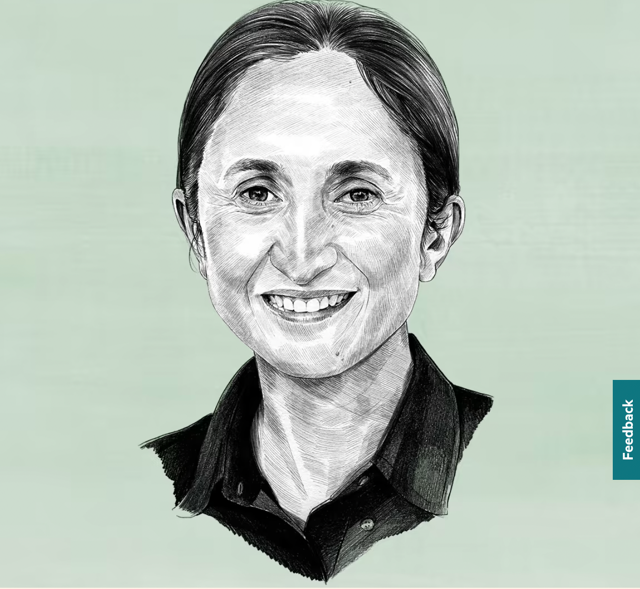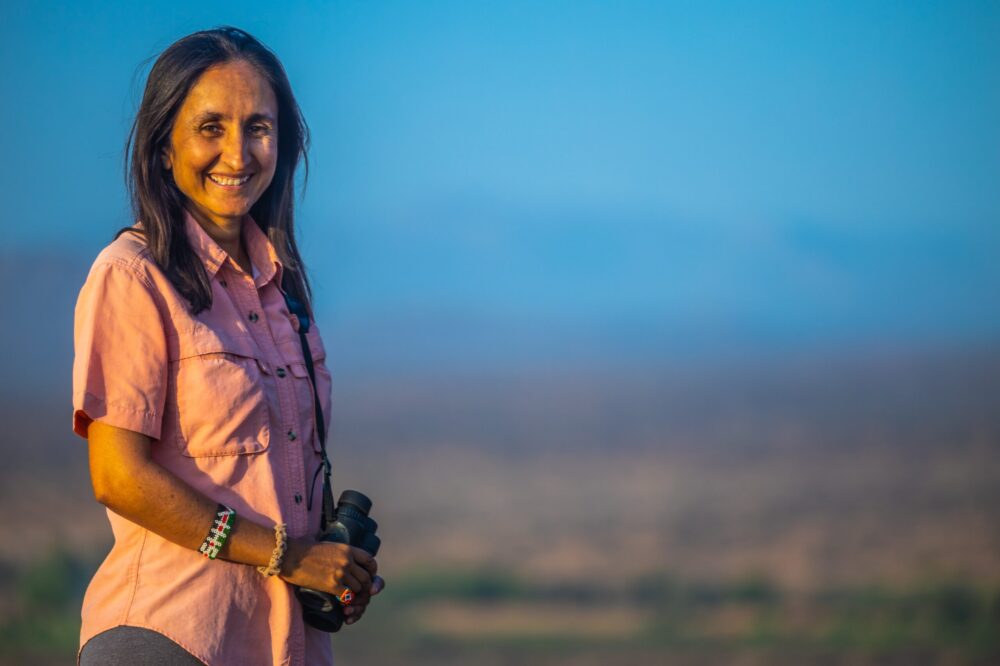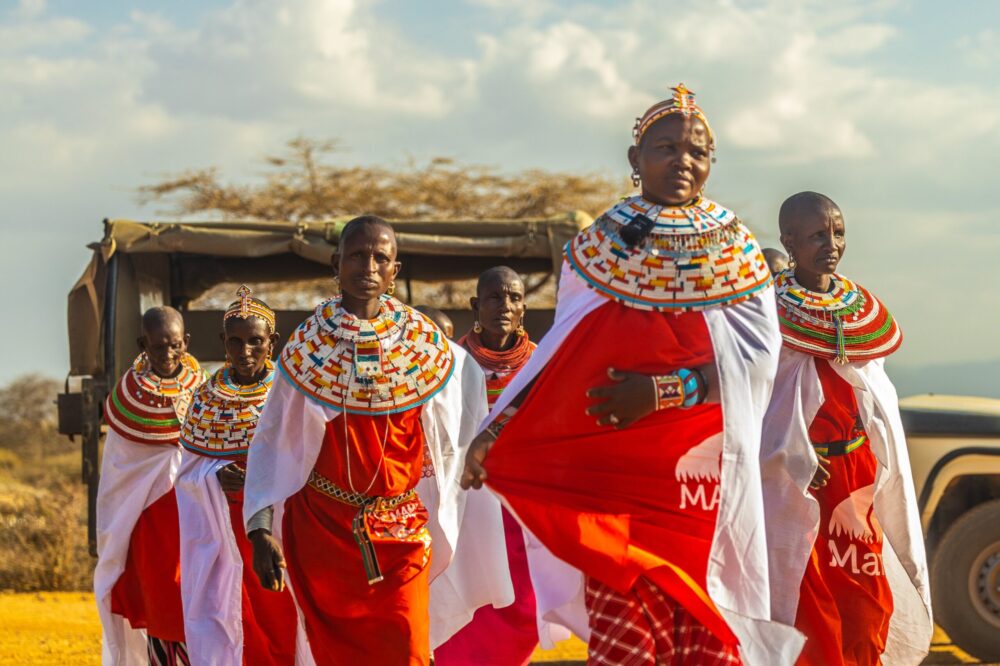The sun is rising high over northern Kenya, the air is hot and dry, and a young man is quietly making his way through the rocky scrubland that stretches for miles in every direction. His name is Lkasian Leringato and he is bare-chested and adorned with the elaborate bead jewellery – necklaces, bracelets and headpieces – that mark him as a warrior of the Samburu people. He is alert, picking his steps and scanning the landscape carefully. As a warrior, one of his responsibilities is to keep his tribe’s livestock safe from harm, and so today he is alone in the bush looking for lions. The need to protect Samburu goats, cattle and camels from these predators is so vital that, according to tradition, a warrior cannot truly call himself a man until he has killed a lion. The 22-year-old keeps moving softly forward, alive to the sight or sound of Africa’s biggest cat. But Leringato has no desire to prove himself by killing a lion.
In fact the idea would horrify him. This is because he and many other young Samburu warriors have made it their mission to preserve the small number of lions that remain in this part of east Africa. Each day, he and his friends will head into the unforgiving landscape to track and monitor the local lion population and, where necessary, intervene whenever an angry herdsman wants to shoot one of the animals in retaliation for the killing of livestock. How did the Samburu people go from being the lions’ chief persecutors to their principal protectors? And why is this dramatic shift being heralded as a model that can change the nature of animal conservation on a global scale? To answer these questions we must stay with Leringato as he returns to a small camp, where he takes a seat in the shade beneath an awning. Beside him is Dr Shivani Bhalla, a zoologist, conservationist and director of an organisation called Ewaso Lions, which she founded here, in the lands near the Ewaso river, in 2007.
Bhalla is 45 and petite, with a bright, open face. She describes how, despite having grown up in the capital, Nairobi, she spent much of her childhood travelling to the more remote regions of Kenya, where her father, who was a rally driver, would compete in crosscountry motor races. “People laugh, because he drove really fast, but I have a reputation for being the slowest driver,” she says, chuckling. At the age of eight, while on safari with her family, she spotted her first cheetah. “And from that moment, I developed a huge obsession with cheetahs and the bush. I just did whatever I could to be near wildlife,” she says. “I still have the photo I took of it in the long grass.” She began to plaster her bedroom walls with posters of cheetahs and was “always dressing in shorts and safari boots”, like some central casting explorer. This obsession endured through university at Lancaster, where she studied environmental science. “I spent two years there and then I came straight back. I couldn’t handle the weather.” Returning home, she began working for the Kenyan Wildlife Service. She was assigned to this part of northern Kenya and hoped to write a thesis on cheetahs. The only problem was that, no matter how hard she looked, she couldn’t find any. So instead she found herself drawn to the local lions, which were only marginally less elusive. She soon became fascinated by how different they were from the lions in other parts of Africa, which were more like the beasts of popular imagination.
“I grew up seeing lions in southern Kenya who operated in big prides, with the males sleeping all day and basically being very lazy,”
she says. But here in northern Kenya, the Ewaso lions were far more solitary and active. “They are unique in their behaviour. And that’s
what really got me to stay. I figured there was so much more to find out about them.” And what she discovered, very quickly, was
that the Ewaso lions were in serious danger. This was one thing they did have in common with other lions. Over the past 20 years, it
is estimated that the African lion population has declined by 43 per cent to about 20,000. Within Kenya, this number is below 2,500.
In her immediate region, there were at best a dozen. The reasons for this are manifold but, she says, it all stems from habitat loss and
food scarcity. “The norm here is now extreme droughts,” says Bhalla. “We don’t get enough rain, the river dries up, there’s no grass in thearea, and the prey that lions depend on doesn’t have enough food.” This creates such pressure on the lions that they increasingly encroach on the lands of the semi-nomadic Samburu people and prey on their livestock. “We’re just running out of space,” she says. A single camel can be worth up to $1,000. “And understandably, when a cow or a camel is killed, the local communities do get very resentful, because their lives depend on that animal. It’s as though their bank account has been wiped out.”
‘The biggest eye-opener about lion conservation? It isn’t about lions. It’s all about people’
So the Ewaso lions found themselves caught between the prospect of starving in the bush or risking death at the hands of angry Samburu tribespeople. Bhalla began to realise that if she wanted to help protect these animals, she needed to understand the people who were killing them. “The biggest eyeopener for me, especially in those first few years when I moved here, was that lion conservation isn’t about lions. It’s nothing about lions. It’s all about people.” Having been living in a remote part of a national park reserved for conservationists, Bhalla realised she had to move to a Samburu village. Not to lecture or chide them, but rather because she genuinely needed the help of people whose own culture was intimately linked with lions and who had grown up around them in a way she had not. “I had no clue,” she says. “I didn’t know what I was doing. I didn’t even know where I was. I didn’t know the area. Me? From Nairobi? Looking for lions? I didn’t have the eye. I would drive around for months and not see a thing,” she says, shaking her head at her own helplessness.
So she began talking to the locals. She learnt that, traditionally, the Samburu people’s relationship with lions had been defined by coexistence rather than conflict. So while it may sometimes have been necessary for a young warrior to kill one, lions also played a key role in Samburu culture. Their roars heralded good fortune. Their presence was required for important rituals and ceremonies. Around 2007, Bhalla met a young man named Jeneria Lekilelei who was intrigued by her presence in his community. Having spent most of his life “hating” lions, he began not only to question his prejudice but to fret about what it would mean for Samburu culture if the Ewaso lions were killed off entirely. After an epiphany that involved him sitting beside a lion “in harmony and without having any
problems”, he started working with Bhalla. Today, Lekilelei laughs when he recalls how, initially, his family and friends couldn’t quite believe he had thrown in his lot with the young woman from Nairobi. “They were like, ‘Have you gone crazy? To follow this little girl
who comes and says, “Let’s promote lion conservation,”’” he says. With Lekilelei and a growing number of other Samburu tribespeople onside, things began to change. Perhaps most importantly, in 2010 Lekilelei created something called the Warrior Watch programme. Samburu culture requires all young men to serve as “warriors” until the age of about 30, living together communally and acting as a kind of militiacum-police force. What Lekilelei proposed was that he and his fellow warriors could patrol their lands looking for lions. And when they spotted some, they would tell local herdsmen to avoid grazing their animals in the area. “So people are more aware of the presence of lions,” he says. “And by doing so, you save the lion and you save the livestock.”
It helped that Lekilelei was – and remains – a loquacious and persuasive presence. “There is no one more skilled at holding a community meeting than Jeneria,” says Bhalla. Nevertheless, he describes how there was still “a lot of resistance” to the idea of conserving lions. One problem was that locals tended to overestimate the number of lions in the area. Another was that the agony of losing herd animals is very real. “I understand how painful it is. Remember when my cow was killed?” he asks Bhalla, who nods soberly. “I was crying.” But by consciously targeting people in his tribe who seemed to have the most influence over others – “the ringleaders” – Lekilelei was able to spread the sense that by helping to keep track of the local lion population, the Samburu warriors were not only protecting their livestock but also the lions and, by extension, their own culture. More and more people became interested in helping to conserve the lions, not just warriors but Samburu women and children too. It also helped that Bhalla remained among the Samburu year after year, becoming more familiar and more accepted. Today, she and her dogs, Kura and Nanyori, are a familiar sight.
“I think 10 or 15 years ago I was known as the crazy lady who runs around after lions,” she says. “But now I’m not crazy any more. A lot of people probably thought I was here for the short term. That maybe I’ll just come, do a PhD and then leave like everybody else does. But it’s been 21 years since I arrived here. This is my home. This is where I live.” Despite intense environmental pressures – it is now the sixth consecutive failed rainy season here – the Ewaso Lions project is succeeding. Retaliatory killings are down markedly and the number of lions in the area has increased from just 11 to more than 50, bucking the continental trend. Bhalla now manages a team of more than 60 people, and it is for this work that she will receive a Gold Award and £100,000 funding from the Whitley Fund for Nature, a UK charity that supports grassroots conservation around the world. She believes the fact that she has stayed among the Samburu people for more than 20 years, and made sure that they were at the heart of her project, is something that traditional “top-down” conservation must learn from. “The big problem is that you get a lot of what are called ‘parachute scientists’ who come in and tell Kenyans how to protect our wildlife, and that has to change. It’s up to us, as Kenyans, to figure out what we need to do,” she says. In the past when encountering such people, she would walk away. Now she confronts them. “I’ll say, what exactly are you doing to build teams? What are you doing to work with communities? What are you doing to ensure communities lead the approaches? And I’ll often just get a blank look.”
The Ewaso Lions model of conservation can – and, in a sense, must – be rolled out globally, she continues. “There are components of it that are transferable, no matter where you are in the world. Community-led wildlife conservation can happen anywhere. And to me, it’s the only solution we have to this biodiversity crisis.” She, Lekilelei and Leringato are preparing to come to London for the Whitley Awards. They’re trying to get tickets to see The Lion King in the West End and Leringato is beginning the process of styling his hair for the occasion, “which can take weeks”, Bhalla teases. He smiles. He describes how, recently, one of the Ewaso lionesses had a problem with her mouth, so the Kenya Wildlife Service had to come and attend to her. During this process, he found himself crouched beside her, stroking her gently and trying to offer some comfort. “I had never believed that there would be a time I would be treating a lion with a problem. It’s a moment I will never forget. And now I am out monitoring her every day, checking that she is OK and eating well,” he says softly. “Now, I know the lions are in my hands.”





